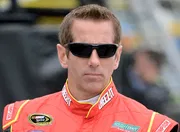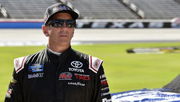
Imago
Richard Petty

Imago
Richard Petty
Richard Petty isn’t just a NASCAR legend, he’s the legend. With that cowboy hat, sunglasses, and a jaw-dropping 200 career wins, “The King” practically ruled the track from the moment he strapped in. Back in the day, especially around the Nashville Fairgrounds, Petty was royalty in every sense. Just ask anyone who watched him dominate the Music City USA 420 in 1974. This was just one of nine wins he racked up at that very track.
Watch What’s Trending Now!
Petty didn’t just race at Nashville. He built a legacy, lap by lap, turning ordinary weekends into racing history. But even with all that track time under his belt, there’s still one twist in modern NASCAR that makes him raise an eyebrow, and maybe even tip his hat. Let’s just say, it’s got something to do with the surface beneath the tires, one that he didn’t race on much, certainly not at Nashville Fairgrounds.
ADVERTISEMENT
Richard Petty weighs in on Nashville’s concrete challenge
Nashville has long been a cornerstone of American motorsports, with its racing legacy stretching back to the early 1900s. The historic Nashville Fairgrounds Speedway first hosted horseless carriages and motorcycles in 1904 and quickly became a proving ground for some of the sport’s greatest drivers. The venue evolved over the decades, with the paved half-mile track opening in 1958 and cementing its place in NASCAR lore.
However, in 1985, the track was removed from the Cup schedule following a management dispute, and while it still races late models, the top tiers of NASCAR shifted to the concrete Nashville Superspeedway, which was opened in 2001, and remains part of a select group of tracks that boast a concrete surface, rather than traditional asphalt.
From 2001 to 2011, only the Truck and Xfinity races took place at Nashville, but since 2021, the Cup Series has started visiting once a year, and the concrete track has provided plenty of wrecks and thrilling races. From Chase Elliott‘s stellar drive in 2023 to the quintuple overtime madness in 2024, where Joey Logano triumphed, the track is not devoid of drama, but what makes it so special? Well, Richard Petty has the answer.
ADVERTISEMENT
Nashville’s concrete surface has a direct impact on both strategy and car setup. As Richard “The King” Petty explained on his latest podcast episode, “Cement tracks are more consistent. I didn’t run that many of them. They started doing a lot of cement, but for me to watch a race, and I think for me to run a cement track, is going to stay more consistent because the weather doesn’t affect it like it does asphalt.”
Research and driver feedback support Petty’s view. Concrete tracks, like Nashville, tend to offer more consistent grip regardless of temperature swings, while asphalt surfaces can become slick and unpredictable as they heat up. This means teams can rely on steadier tire performance and lap times over long green-flag runs on concrete. The 2025 Xfinity race saw these dynamics in action, with drivers like Connor Zilisch and Justin Allgaier able to maintain pace deep into each stage.
ADVERTISEMENT
View this post on Instagram
Petty’s longtime crew chief, Dale Inman, echoed this, recalling, “We didn’t run that many concrete tracks, I think. Martinsville was probably the first one that just concreted the corners because they couldn’t get the asphalt to hold (to stay down). That’s the reason they done it.” Martinsville Speedway first paved its surface with asphalt in 1955, but by the 1970s, the powerful Cup cars were tearing up the turns. To address this, the track replaced the corners with concrete in 1976, creating its now-iconic combination of asphalt straightaways and concrete turns that remain today.
For Petty, Nashville’s concrete surface isn’t just a technical footnote. Rather, it’s a defining feature that shapes the racing product, rewards precision, and adds another layer to the city’s rich motorsports heritage.
ADVERTISEMENT
Top Stories
NTSB Appeals for Greg Biffle’s Wife’s Alleged In-Flight Text Messages as Crash Investigation Heats Up

Donald Trump Issues Moving Message of Condolence for NASCAR’s Greg Biffle & Family During North Carolina Address

Another Almost Fatal Disaster Surfaces From Statesville Airport Amidst Ongoing Greg Biffle’s Crash Investigation

Air Safety Investigator Probes Possible Co-Pilot Role Amid Greg Biffle’s Fatal Plane Crash Investigation

Greg Biffle’s Haunting Aviation Admission Resurfaces Hours After Tragic NC Plane Crash

Richard Petty’s Nashville reign
Richard Petty’s legacy in Music City is especially notable, with Nashville Fairgrounds Speedway serving as one of his most successful tracks during the golden era of stock car racing. From 1958 to 1984, the Fairgrounds hosted 42 Cup Series events, and Petty’s record there is unmatched. He captured nine victories! This is more than any other driver in the track’s Cup history, edging out even local favorite Darrell Waltrip.
Petty’s dominance at Nashville was immediate and sustained. Between 1964 and 1967, he won five consecutive races at the Fairgrounds, three of them from the pole position. His 1966 Nashville 400 performance stands out as one of the most commanding wins of his career. Petty started on pole, led all 400 laps, and lapped the field five times, finishing with an average race speed of 71.770 mph. That day, he outpaced a field of 28 drivers, including future stars like Bobby Allison and Coo Coo Marlin. He left no doubt about his mastery of the half-mile paved oval.
ADVERTISEMENT
Petty’s success at Nashville wasn’t just about individual races; it was part of a broader family tradition. “All four generations of Pettys ran there, and there are very few race tracks that can say that,” Petty said, reflecting on the Fairgrounds’ special place in the Petty family story. His father, Lee Petty, also raced at the Fairgrounds, never finishing worse than sixth in his four starts between 1958 and 1960.
Petty’s Nashville legacy is one of consistency, speed, and adaptability. Whether starting up front or coming from behind, he was always a threat to win. As he put it, “We always looked forward to going there, because we always had a chance to win there. It wasn’t all a Darrell Waltrip operation.” For generations of NASCAR fans, Petty’s Nashville triumphs remain a testament to his status as “The King.”
ADVERTISEMENT
ADVERTISEMENT
ADVERTISEMENT
ADVERTISEMENT

